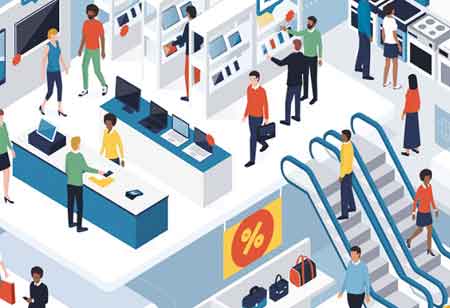Thank you for Subscribing to Construction Business Review Weekly Brief

The Technological Evolution In The Construction Industry
The construction industry has been on a journey of digital transformation over the past few years and proven, emerging technologies are creating huge opportunities for us all to improve project performance. The true value lies in our data and the ability to harness it across the end-to-end project lifecycle, to deliver better outcomes for clients and throughout the supply chain. Through data, we can connect people and technology to be the source of real-time insight, continually elevating decision-making, providing more on-site certainty, increasing industry productivity, and improving commercial outcomes for all involved.
The construction industry’s stagnant productivity – which has seen just 1 percent growth annually over the past two decades – has been the subject of much analysis and debate. However, as industry processes have become more data-driven and standardization in the design phase the default where possible – allowing construction sequences to be rehearsed digitally – it has become apparent that the real issue affecting productivity is at the interface between the design or construction phase.
Data and AI are now allowing us to look at this productivity problem with fresh perspective and introduce a whole new set of tools to better handle project set up, management and deliverables. By digitising processes, employing advanced analytics and AI to derive better insights, and creating superior working models, it’s now possible to run millions of permutations of how a project schedule and costs will be impacted in a given situation, to ensure the right course of action is taken. Progress can be monitored based on solid facts, to get an objective assessment of the project’s status, instead of relying on informal conversations with stakeholders. When a problem does occur, it also brings the ‘flash to bang’ time down to hours or days, instead of weeks and months, in line with far more productive industries, like manufacturing.
The benefits of data and digital
Advantages of digital transformation are appearing far and wide. For example, digital process lends itself to pre-formed building elements, such as Modular Integrated Construction (MiC), which means a safer construction process. This, combined with rehearsed construction sequences, can digitally create building component sequences that can be transported and lifted into place, enhancing productivity and speed of construction throughout the process. This applies to infrastructure projects as much as traditional building construction methods.
There’s virtually unanimous agreement on the need for better digital skills and processes in the planning, engineering and construction industry
Meanwhile, digitally modelling the whole construction sequence creates a better understanding of carbon calculations in the build process, as well as a future understanding of maintenance and replacement issues, embodied energy, and re-cyclable construction materials and components.
By unlocking superior insights from data and enabling teams to make better decisions at the design/ construction interface, we estimate that design costs can be lowered by more than 10 percent and construction costs by more than 5 percent. The hope is that these benefits continue to grow exponentially, and the pent-up productivity gap starts to be released.
With so many major projects overrunning significantly on time and cost, even pulling these in line with where we thought they would perform at the outset would be a huge win.
Ultimately though, becoming data-driven isn’t about the tools or software packages you use – that’s just one element. It’s about embracing a completely new way of working that empowers usall to extract, aggregate, and analyse the data we need quickly and effectively. To that end, there’s virtually unanimous agreement on the need for better digital skills and processes in the planning, engineering and construction industry. Innovative, new construction processes like MiC are already here but they require specialized skill sets and people who fully understand sequencing, in order to positively affect productivity within the build.
 With increasing business, legislative, and environmental pressure to evolve our ways of working, now is the time to set the groundwork, to create a generation of workers who are curious, digitally literate, and ready to take our industry to the next level. Raising our digital standard requires us to work with our employees to change the way they think about, and approach, the work they do every day. More collaborative ways of working are becoming increasingly important, not just on-site or in the office but in the digital world too. For example, when numerous designers, some of whom could be partners or competitors, are jointly working in a 3D model. Embracing that means adopting new processes and platforms that replace the ones we might have been using for years.
With increasing business, legislative, and environmental pressure to evolve our ways of working, now is the time to set the groundwork, to create a generation of workers who are curious, digitally literate, and ready to take our industry to the next level. Raising our digital standard requires us to work with our employees to change the way they think about, and approach, the work they do every day. More collaborative ways of working are becoming increasingly important, not just on-site or in the office but in the digital world too. For example, when numerous designers, some of whom could be partners or competitors, are jointly working in a 3D model. Embracing that means adopting new processes and platforms that replace the ones we might have been using for years.
The future of construction
Looking to the future, construction companies must ensure they are building out a strong technology capability across their businesses, whose attention they can direct at solving the issues presented by digital transformation. This is a cultural challenge as much as a practical one. Businesses must also encourage new ideas from more technology, data, and cyber savvy colleagues and actively back them, embracing the ensuing changes to traditional ways of working and being willing to experiment with pilot projects to get things off the ground. If they do, there’s every reason to believe that productivity could improve dramatically as a result.
 Our industry also needs to nurture a new generation of worker that instinctively embraces learning and will drive forward new ways to tackle both design and build. This isn’t about replacing existing workers with new recruits; much of our corporate know-how resides in the minds of highly skilled and experienced professionals. It is about combining new people and skills with those already working in the industry to elevate everyone. The challenges we face today require greater diversity of thought and skill, a digital-first mentality, experimentation, and creativity. By folding the knowledge that has served us well for years into a wider digital transformation plan, we can be fully ready for the connected future.
Our industry also needs to nurture a new generation of worker that instinctively embraces learning and will drive forward new ways to tackle both design and build. This isn’t about replacing existing workers with new recruits; much of our corporate know-how resides in the minds of highly skilled and experienced professionals. It is about combining new people and skills with those already working in the industry to elevate everyone. The challenges we face today require greater diversity of thought and skill, a digital-first mentality, experimentation, and creativity. By folding the knowledge that has served us well for years into a wider digital transformation plan, we can be fully ready for the connected future.








